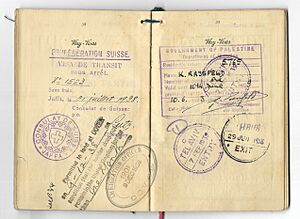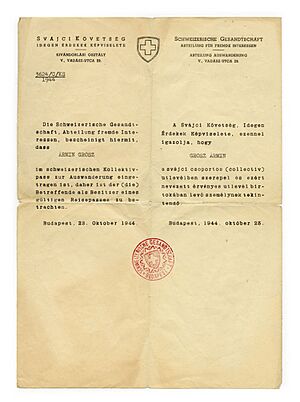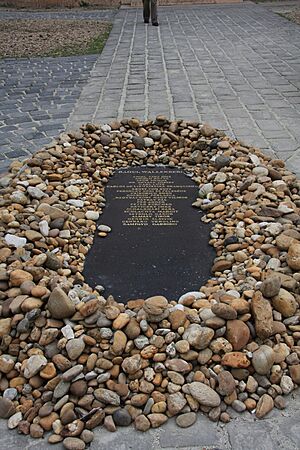Carl Lutz facts for kids
Quick facts for kids
Carl Lutz
|
|
|---|---|

Lutz in 1944
|
|
| Swiss Vice-Consul to Hungary for Budapest | |
| In office January 1942 – 1945 |
|
| Personal details | |
| Born | 30 March 1895 Walzenhausen, Switzerland |
| Died | 12 February 1975 (aged 79) Bern, Switzerland |
Carl Lutz (born March 30, 1895 – died February 12, 1975) was a brave Swiss diplomat. He worked as the Swiss Vice-Consul in Budapest, Hungary, from 1942 until the end of World War II. He is famous for saving more than 62,000 Jewish people during the war. This was a very large rescue effort.
Because of his actions, half of Budapest's Jewish population survived. They were not sent to Nazi extermination camps during the Holocaust. He was later honored with the title of Righteous Among the Nations by Yad Vashem. This title is given to non-Jews who risked their lives to save Jews during the Holocaust.
Contents
Carl Lutz's Early Life and School
Carl Lutz was born on March 30, 1895. His parents were Johannes and Ursula Lutz. He grew up in Walzenhausen, Switzerland, a town in the mountains. He went to local schools there. His father owned a quarry, which is a place where stone is dug from the ground. When Carl was fourteen, his mother passed away from tuberculosis.
At age 15, he started working in a textile factory. In 1913, when he was 18, he moved to the United States. He lived and worked there for over 20 years. From 1913 to 1918, he worked in Granite City, Illinois. He saved money for college. He then studied at Central Wesleyan College in Warrenton, Missouri, from 1918 to 1920.
In 1920, Lutz began working for the Swiss government. He joined the Swiss consular corps in Washington, D.C.. He continued his studies at George Washington University. He earned his bachelor's degree in 1924. Carl Lutz was a Methodist, a type of Christian faith.
Carl Lutz's Diplomatic Career
In 1926, Carl Lutz became a chancellor at the Swiss Consulate in Philadelphia, USA. After that, he worked at the Swiss Consulate in St. Louis. He served in these two cities from 1926 to 1934.
In 1934, he met Gertrud Fankhauser. They got married in January 1935. Lutz then left the United States after living there for more than 20 years. In January 1935, he was sent to Jaffa, in what was then Mandatory Palestine. He worked there as a vice-consul until 1942.
Carl Lutz's Actions During World War II
In 1942, Carl Lutz was sent to Budapest, Hungary, as the Swiss vice-consul. Soon after arriving, he started working with the Jewish Agency for Israel. He began giving out special Swiss documents. These documents, called safe-conducts, helped almost 10,000 Hungarian Jewish children leave the country. Overall, he saved more than 62,000 Jewish people.
When the Nazis took over Budapest in 1944, they started sending Jews to death camps. Lutz made a special agreement with the Hungarian government and the Nazis. He got permission to issue protective letters to 8,000 Hungarian Jews. These letters allowed them to move to Palestine.
Lutz cleverly stretched this permission. He said the 8,000 applied to families, not just individuals. This way, he issued tens of thousands of extra protective letters. All of them had a number between one and 8,000. He also set up about 76 "safe houses" around Budapest. He declared these houses part of the Swiss legation (embassy). This meant Hungarian or Nazi soldiers could not enter them.
One famous safe house was the "Glass House" (Üvegház) at Vadász Street 29. About 3,000 Hungarian Jews found safety there. They also found refuge in a building next door.
One day, Carl Lutz saw fascist soldiers from the Arrow Cross Party shooting at Jews. He bravely jumped into the Danube River to save a bleeding Jewish woman. The river water was up to his chest. He swam back to the bank with her. He then demanded to speak to the Hungarian officer in charge. Lutz declared the wounded woman a foreign citizen. He said she was protected by Switzerland. He quoted international laws. The Swiss consul then took her to his car. The fascists were stunned and did not stop him.
Carl Lutz worked with other diplomats from neutral countries. These included Raoul Wallenberg from Sweden. Also, Carlos de Liz-Texeira Branquinho and Carlos Sampaio Garrido from Portugal. Angelo Rotta, the Pope's representative, also helped. Angel Sanz Briz from Spain, and later Giorgio Perlasca, an Italian businessman, joined them. Friedrich Born from the Red Cross also helped. They all worked hard to save innocent people. Lutz used his diplomatic skills to convince Nazi officials, like Adolf Eichmann, to allow his protection of Hungarian Jews. His efforts were so bold that a German official even asked if he could assassinate Lutz. But Berlin never gave permission.
The Swiss Minister, Maximilian Jaeger, supported Lutz. He left when the Soviet Army got close in late 1944. In the last weeks, Harald Feller helped Lutz. Lutz's wife, Gertrud, also played a very important role. She supported her husband's activities in Budapest.
After the Second World War
Carl Lutz and his wife went back to Switzerland in January 1945. They divorced in 1946. In 1949, he married Magda Csányi. She was a woman he had protected during the war. Carl Lutz retired in 1961. He died in Bern, Switzerland, in 1975.
Carl Lutz's Legacy and Honours
Carl Lutz saved tens of thousands of lives. However, his actions were not immediately recognized in Switzerland. After the war, the Swiss government criticized him. They said he had gone beyond his authority. They were worried about Switzerland's neutral status. Many years later, in 1958, Switzerland re-evaluated its wartime history. Lutz was then honored for his achievements.
- In 1963, a street in Haifa, Israel, was named after him.
- A small street in Jerusalem's Neve Yaakov neighborhood is also named after Carl Lutz.
- In 1965, Lutz was the first Swiss person to be named a "Righteous Among the Nations" by Yad Vashem.
- He received the Cross of Honor, a high award from Germany.
- In 1991, a memorial was built for him at the entrance to the old Budapest ghetto.
- In 1998, Lutz appeared on an Israeli postage stamp.
- In 2014, George Washington University honored Lutz. They gave him the President's Medal after he passed away.
- His name is on The Raoul Wallenberg-memorial at the Dohány Street Synagogue in Budapest.
- In 2017, a scenic lookout was built in his memory in Switzerland Forest.
- In 2018, a meeting room in the Federal Palace of Switzerland was renamed the Carl Lutz room.
- The Carl Lutz Society works to promote his legacy.
See also
- Walking with the Enemy
- Shoes on the Danube Bank
Images for kids






